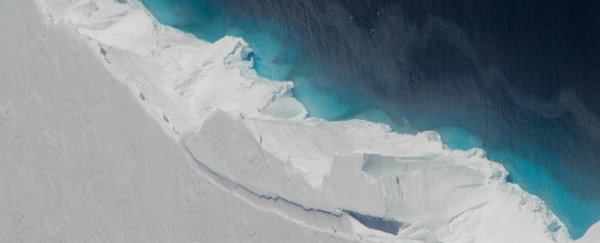A new study published Tuesday has found that warm ocean water is carving an enormous channel into the underside of one of the key floating ice shelves of West Antarctica, the most vulnerable sector of the enormous ice continent.
The Dotson ice shelf, which holds back two separate large glaciers, is about 1,350 square miles (3,500 km square) in area and between 1,000 and 1,600 feet (300 and 490 metres) thick.
But on its western side, it is now only about half that thickness, said Noel Gourmelen, a researcher at the University of Edinburgh in Scotland and the lead author of the research, which was just published in Geophysical Research Letters.
The reason is the same one that is believed to be shrinking glaciers and pouring ice into the ocean across West Antarctica - warm ocean water located offshore is now reaching the ice from below.
In Dotson's case, it appears the water is first flowing into the deep cavity beneath the shelf far below it, but then being turned by the Earth's rotation and streaming upward toward the floating ice as it mixes with buoyant meltwater.
The result is that the warm water continually melts one part of the shelf in particular, creating the channel.
"We think that this channel is actually being carved for the last 25 years," said Gourmelen, whose research team detected the channel using satellite observations.
"It's been thinning and melting at the base for at least 25 years, and that's where we are now."
The work was conducted by researchers at the University of Edinburgh along with colleagues at other institutions in France, Norway, the United Kingdom and the Netherlands.
The newly discovered channel is 3 miles (5 km) wide and 37 miles (60 km) long, and the scalloped region at the base of the floating ice shelf is mirrored by a long depression on its surface.
Dotson ice shelf as a whole has been thinning at an average rate of more than eight feet per year since 1994, even as the speed of ice flowing outward through the shelf has increased by 180 percent.
But the thinning in the channel has been far greater. The research calculates that 45 feet (14 metres) of ice thickness is being subtracted annually from the channel.
The new study calculates that as a result of this highly uneven melting, the Dotson ice shelf could be melted all the way through in 40 years, rather than 170 years, which would be the time it would take if the melt were occurring evenly.
And it speculates that as the thinning continues, the shelf may not go quietly or steadily any longer - something dramatic could occur, such as a breakup.
"Any carpenter knows: you're going to cut through a block of wood a lot faster with a saw than with a sander," said Ted Scambos, an Antarctic expert with the National Snow and Ice Data Center, who commented on the study by email (he was not involved in the research).
"What they've shown is that warm ocean water reaching the Antarctic coastline beneath the ice does not just remove the ice uniformly, it cuts deep gouges in the ice from below. The channels are weak spots in the floating ice (ice shelves)."
Meltwater from this process streams outward into the Amundsen Sea in front of the Dotson ice shelf and the channel, which has large downstream consequences.
The water carries nutrients, such as iron, that have also spurred sharp growth of marine microorganisms in the region - another sign of the major changes in the region.
"This study reveals the complexity with which the ocean interacts with Antarctic ice shelves, and will be of value in assessing the future of the ice-ocean-biology system of the Antarctic coastline, and its sensitivity to changes in climate," said Dan Goldberg of the University of Edinburgh, another of the study's authors.
Helen Fricker, a glaciologist at the Scripps Institution of Oceanography, said the new research highlights the importance of a European Space Agency satellite called CryoSat-2, which she said is "currently the only satellite monitoring Antarctica's ice shelf thickness."
"It gives us data at incredibly dense coverage, which is allowing us to map small-scale features like basal channels," Fricker said.
"These are regions of higher basal melt, and could cause the ice shelf to weaken much sooner than the average melt rates imply. It is vital that we keep monitoring these ice shelves."
There could be numerous other such channels across the Antarctic continent, Gourmelen said.
In the particular case of Dotson, the ultimate fear is that the undermining of the shelf will increase the flow of ice outward from the glaciers behind it, named Smith and Kohler, which contributes to sea level rise. If the ice shelf collapsed, that would speed up even further.
To see why that matters, consider this map of what the overall region looks like, where "DIS" refers to Dotson ice shelf:
 Noel Gourmelen
Noel Gourmelen
The map above shows Dotson Ice Shelf and the Amundsen Sea Sector of West Antarctica. Colors show ice flow of grounded ice across the grounding line (white line) feeding floating ice shelves (DIS and Crosson Ice Shelf (CIS)), as well as ocean regions of high annual primary productivity (APP).
In the long term, the greatest fear perhaps is that Smith glacier ultimately connects to Thwaites glacier, the largest in West Antarctica, as you can see above. Thwaites runs backward all the way into the heart of the West Antarctic ice sheet, which contains about 10 feet of potential sea level rise.
"The nature of the impact is not really known" if Dotson is lost, Gourmelen said. "But they are essentially part of the same large basin."
2017 © The Washington Post
This article was originally published by The Washington Post.
